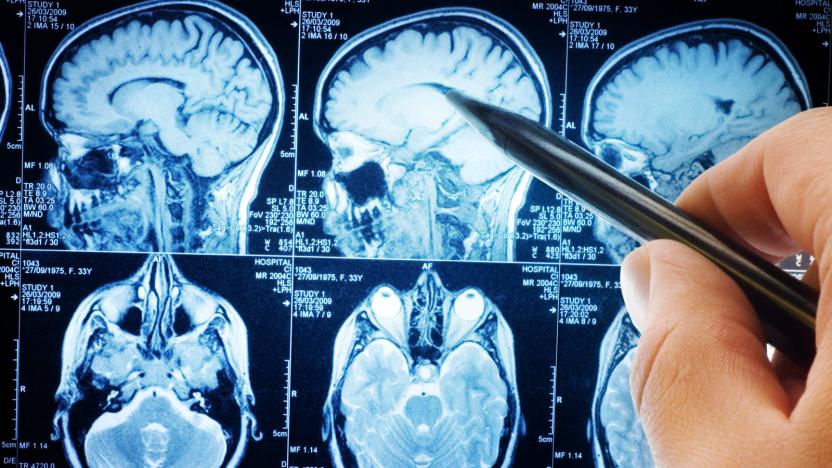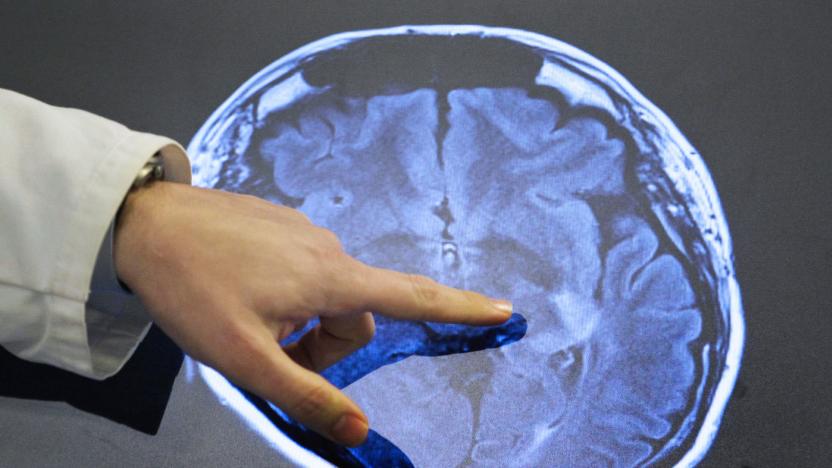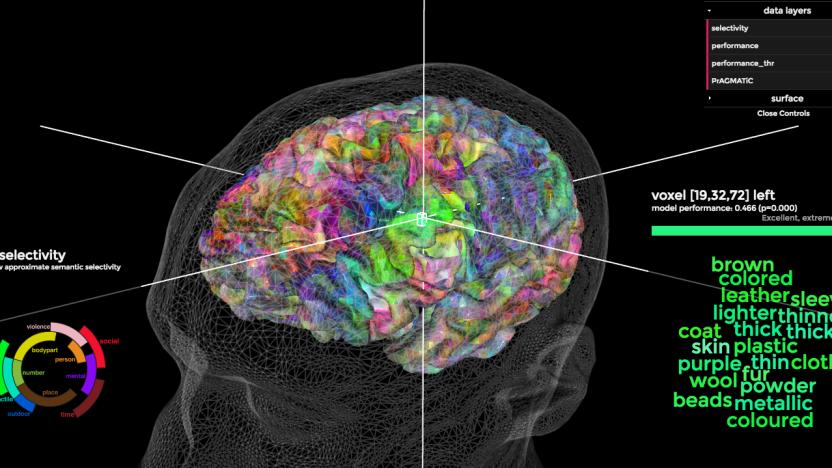brain
Latest

Fluctuating brain networks help you handle complex tasks
Researchers already know that the human brain isn't static, but it's now clear just how dynamic the mind can be. A Stanford University team has discovered that the networking between brain regions will fluctuate depending on the complexity of tasks. If you're at rest, your brain's components are relatively isolated. Handle a complicated activity, however, and the level of networking ramps up. The more interconnected your brain is, the better your performance -- in a memory test, those with the most integrated brains were the quickest and most accurate.

Presenting the most comprehensive map of the human brain
Ask a neurologist -- as far as brains go, humanity has one of the largest and most complex thinking muscles on the planet. That's why researchers have never really had a good atlas of the human brain's underlying structure. According to the Allen Institute, documentation on the model of the human brain is so outdated, that it's still commonplace for scientists to reference mappings from almost a century ago. Well, at least it was: the Institute has just published what it says is the highest resolution atlas of the human brain, one it hopes will become a new standard resource for brain researchers.

Dogs understand what you're saying, not just the sound of your voice
One pinnacle of human development has been the ability to comprehend language, thought to be a major achievement separating us from the animals. So it was assumed with dogs, but new research reveals that canines understand more subtleties in speech than we thought thanks to similarities in brain regions to those of humans.

Zika virus' effects are broader than first thought
The Zika virus is primarily known to cause microcephaly (small heads) in the babies of infected mothers, but its effects may be wider-ranging than first thought. A Harvard-led study has conducted brain scans of 45 Brazilian babies from Zika-stricken mothers, and the data suggest that even those children born without conspicuous problems may suffer later on. Ultimately, Zika is disrupting brain development -- microcephaly is a frequent result of that, but there can also be issues around the cortex (which is crucial to coordination and memory) that show up first and may only materialize on the outside as the child grows. Moreover, Zika can damage nerves in such a way that it forces arms and hands to contract.

We don't understand AI because we don't understand intelligence
Artificial intelligence prophets including Elon Musk, Stephen Hawking and Raymond Kurzweil predict that by the year 2030 machines will develop consciousness through the application of human intelligence. This will lead to a variety of benign, neutral and terrifying outcomes. For example, Musk, Hawking and dozens of other researchers signed a petition in January 2015 that claimed AI-driven machines could lead to "the eradication of disease and poverty" in the near future. This is, clearly, a benign outcome. And then there's the neutral result: Kurzweil, who popularized the idea of the technological singularity, believes that by the 2030s people will be able to upload their minds, melding man with machine. On the terrifying side of things, Musk envisions a future where humans will essentially be house cats to our software-based overlords, while Kurzweil takes it a step further, suggesting that humans will essentially be eradicated in favor of intelligent machines.

3D imaging helps map tiny connections in the brain
Mapping brain connections is tricky -- chemicals can destroy the very structures you're trying to map, and an electron microscope can only tell you so much. MIT researchers aren't daunted, however. They've developed a new 3D imaging technique that lets you map the brain at multiple scales, including at resolutions that aren't practical with light-based microscopes. The new approach expands on a conventional chemical-based method of preserving brain tissue samples. If you flood the tissue with acrylamide polymers, you form a super-dense gel that lets you expand the sample up to 5 times its original size without hurting its structure, making it easier to study minute details. Numerous microscopes can study neural structures like synapses at resolutions as fine as 60 nanometers, which beats the 200nm you might get through conventional light microscopes.

Researcher proposes method for growing brain cells in 3D
A new method has been proposed that could allow scientists to develop a "3D brain-on-a-chip." Something which could offer researchers a new platform to develop a far better understanding of how brain cells react to medication in a real setting.

Brain-like computers may now be realistic
Power consumption is one of the biggest reasons why you haven't seen a brain-like computer beyond the lab: the artificial synapses you'd need tend to draw much more power than the real thing. Thankfully, realistic energy use is no longer an unattainable dream. Researchers have built nanowire synapses that consume just 1.23 femtojoules of power -- for reference, a real neuron uses 10 femtojoules. They achieve that extremely low demand by using a wrap of two organic materials to release and trap ions, much like real nerve fibers.

Ultrasound implant can help chemo drugs reach brain tumors
One of the biggest problems with brain cancer treatment is that only a limited amount of chemotherapy drugs make it through. See, our brain's blood vessels are tightly lined with cells to keep out toxins and pathogens. The bad news is that it also hinders medicine from reaching tumors. A team of French scientists have recently tested a promising answer to that issue: an ultrasound implant that they designed to temporarily make this "blood-brain barrier" permeable. They ran a pilot with 15 patients suffering from glioblastoma, an aggressive form of brain cancer, and results showed that their technique successfully allowed more medicine to pass through.

Biotech companies get permission to test brain death reversal
Brain death in humans is normally considered irreversible. Even if you keep the body running, those damaged brain cells just won't recover to the point where you get a fully functioning person again. However, that isn't stopping Dr. Himanshu Bansal and his partners at Bioquark and Revita Life Sciences. They recently received approval from American and Indian review boards to conduct a trial aimed at eventually reversing brain death in humans. The initial, months-long test will use multiple techniques to try and regenerate brains in 20 patients, including lasers, nerve stimulation and injections of both peptides as well as stem cells.

Scientists use 'Moth Radio Hour' to map meaning across the brain
Researchers at the University of California, Berkeley took on the complex task of mapping meaning along the cerebral cortex, the thin membrane that stretches across the entire brain, and their results suggest language is much more complex than previously thought. Seven volunteers listened to The Moth Radio Hour, a program where people share emotional personal tales, while lying in a functional MRI machine that tracked how their brains responded to 985 specific concepts, Science News says. Researchers mapped the blood flow to 60,000 to 80,000 pea-sized regions across the cerebral cortex, resulting in a dense word map covering the entire brain. Turns out, some concepts showed up in several areas across the brain: "Top," for example, appeared in a section that handles clothing and one that deals with numbers.

LSD makes you think like a baby
Researchers at Imperial College London believe that they know what effect LSD has on the human brain. After pumping test subjects full of the stuff and shoving them in an MRI, the team learned that the drug makes our brains behave similarly to that of a baby. In order to understand this, imagine that your mind is the single floor of an office, with cubicles running as far as the eye can see. Each cubicle is responsible for different jobs, such as memory, balance and hearing, only talking to each other on the annual company retreat. LSD is like a disgruntled former employee, temporarily smashing down the plyboard dividers and forcing everyone to collaborate.

Scientists identify neurons that help you process emotions
Scientists just got one step closer to understanding the nuts and bolts of how your mind handles emotions. An MIT team has identified two neural connections in the brain's amygdala regions that process positive and negative emotional events. By tagging neuron groups with a light-sensitive protein, they discovered that the neurons form parallel but complex channels that respond differently to given situations. Some neurons within one of those connections will be excited by a feeling, while others will be inhibited -- the combination of those reactions in a given channel may determine the emotion you experience.

Patient wears VR headset to map brain during surgery
Virtual reality is becoming increasingly useful when it comes to the medical field, and doctors in France have taken notice. At Angers University Hospital in western France, physicians used a VR headset to map a patient's brain during surgery to remove a tumor late last month. The patient was conscious during the procedure (a common practice) in which doctors used a virtual environment to map zones of the brain. Until now, said mapping and monitoring neural connections in certain areas weren't easily achieved in the operating room.

Scientists predict human thought in real time, nearly every time
Neuroscientists from the University of Washington have decoded brain signals in real-time and with astounding accuracy, as revealed in a recent study published in PLOS Computational Biology. Researchers attached electrodes to the temporal lobes of seven epilepsy patients for roughly one week -- the implants were part of a program that aimed to locate the sources of these patients' seizures, but while the electrodes were active, the patients also participated in this brain-wave study. Researchers were in the neighborhood, after all.

Scientists better understand the roots of schizophrenia
Scientists already know that schizophrenia has genetic roots, but the condition has still been something of a mystery. How, exactly, does it get started? Researchers at Harvard and MIT now have a better idea. Thanks to both lab testing and a 100,000-person sample of DNA, they've determined that an immune system gene (complement component 4, aka C4) can play an important role in the disease. If a variant of C4 is too active in pruning brain synapses (severing links between neurons) during adolescence, the risk of developing schizophrenia goes up -- it's breaking connections at a key point in development.

Brain monitoring chips dissolve when you're done with them
By far the biggest danger of brain implants is rejection -- it can be just a matter of time before your immune system freaks out and makes a bad situation that much worse. That's where Washington University might come to the rescue. Its researchers have crafted tiny (smaller than a pencil tip) wireless brain sensors that dissolve. Their mix of silicone and polylactic-co-glycolic acid (PLGA) is sophisticated enough to transmit vital data like cranial pressure and temperature, but melts after a few days of exposure to typical organic matter.

Lumosity settles claims it misled you over 'brain training'
Did you see the endless wave of Lumosity brain training ads and think there was no way that a bunch of games could significantly improve your mind? You're not alone. The brand's parent company, Lumos Labs, is paying the Federal Trade Commission $2 million to settle charges that it misled customers with bogus claims about Lumosity's abilities. The FTC doesn't beat around the bush: it says there's no evidence to support talk of boosting your intellectual performance. Moreover, Lumosity doesn't disclose that many of its testimonials are solicited through contests, and its ads "preyed on consumers' fears" about aging.

Watch a worm's brain light up as it plots its next move
Scientists have created the first ever video of neurons firing in a freely moving animal, a technique that could lead to greater understanding about how our own brains work. The Princeton-led team first programmed a nematode worm's neurons to create a fluorescent protein that lit up in response to calcium. Since calcium is generally present when a neuron fires, that means they could literally visualize the 1 millimeter-long worm "thinking" as it wriggles around. The resulting video (below) shows 77 of the nematode's 302 neurons working in the top panel, while the bottom panel simultaneously shows its activities and brain position.

ICYMI: Genetically-based cancer meds, taste's base and more
#fivemin-widget-blogsmith-image-37143{display:none;} .cke_show_borders #fivemin-widget-blogsmith-image-37143, #postcontentcontainer #fivemin-widget-blogsmith-image-37143{width:570px;display:block;}try{document.getElementById("fivemin-widget-blogsmith-image-37143").style.display="none";}catch(e){}Today on In Case You Missed It: Scientists managed to turn taste on and off in mice by activating and silencing brain cells, putting to bed the notion that taste is determined by the tongue. University of Toronto cancer researchers used a patient's genetic material to craft a cancerous mass on a long strip of collagen, then wound it up and gave it the same radiation and chemo drugs a patient would get for that type of illness. They can then stretch the roll out to see whether the treatment killed the cancer cells. The team hopes to eventually tailor people's cancer treatments to their own genetics. And the first battle in the private company space race may have gone to Blue Origin over Space X, for landing its reusable rocket first.








